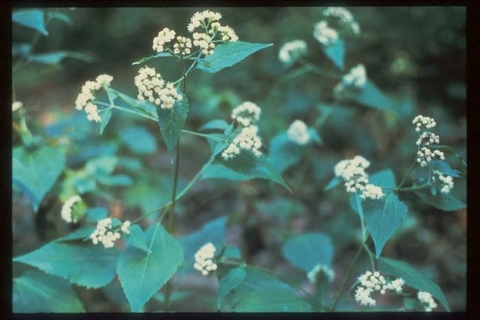Quick facts
-
Don’t allow your horse to eat white snakeroot. Horses may die one to two days after eating white snakeroot.
-
White snakeroot has smooth upright stems, tooth-edged leaves and white flower clusters.
-
White snakeroot grows in shady areas and woodlands.
-
Applying multiple rounds of herbicide, fencing horses out and mowing are the best control practices.
Identifying
-
One to three feet tall
-
Stems are smooth, upright and branched at the top
-
Leaves have toothed edges and taper to a pointed end
-
Small white flowers arranged in clusters
White snakeroot is a perennial.
White snakeroot grows from Minnesota south to northern Louisiana and east except for the Florida peninsula.
White snakeroot grows only in shady areas. You can find it in,
-
Hardwood forests
-
Timber areas
-
Woodlands
-
Damp and shady pastures
Toxicity
An oil extract in the white snakeroot makes the plant toxic to horses. The plant’s oil extract content declines slowly as it dries. But poisoning can still occur in horses that eat white snakeroot in hay or as dry plant stalks. White snakeroot is also toxic when horses eat it fresh.
There are no reports for the exact toxicity levels for horses. But horses are generally believed to be more prone to white snakeroot than ruminant livestock. Toxicity in cattle occurs after they eat 5 to 10 percent of their bodyweight over a few days.
Horses may die one to two days after eating the plant. Signs may include:
-
Difficulty swallowing
-
Muscle trembling
-
A base-wide stance holding their head near the ground
As the disease progresses, skeletal and heart muscle damage occurs and horses aren’t able to stand.
Remove horses from the white snakeroot source. Activated charcoal, followed by a laxative, may reduce absorption or prevent reabsorption of the oil extract.
Control
-
Don’t allow your horses to graze this plant under any circumstance.
-
Fence off wooded areas.
-
Provide supplemental feed to horses on pasture (especially in the late fall or during dry conditions).
-
Be aware that a single application of herbicide won’t control white snakeroot. You will need to apply a herbicide multiple times.
Fencing horses out, mowing and applying herbicides multiple times may be the best control options. Always carefully follow information on herbicide labels, including grazing restrictions.
Reviewed in 2021




